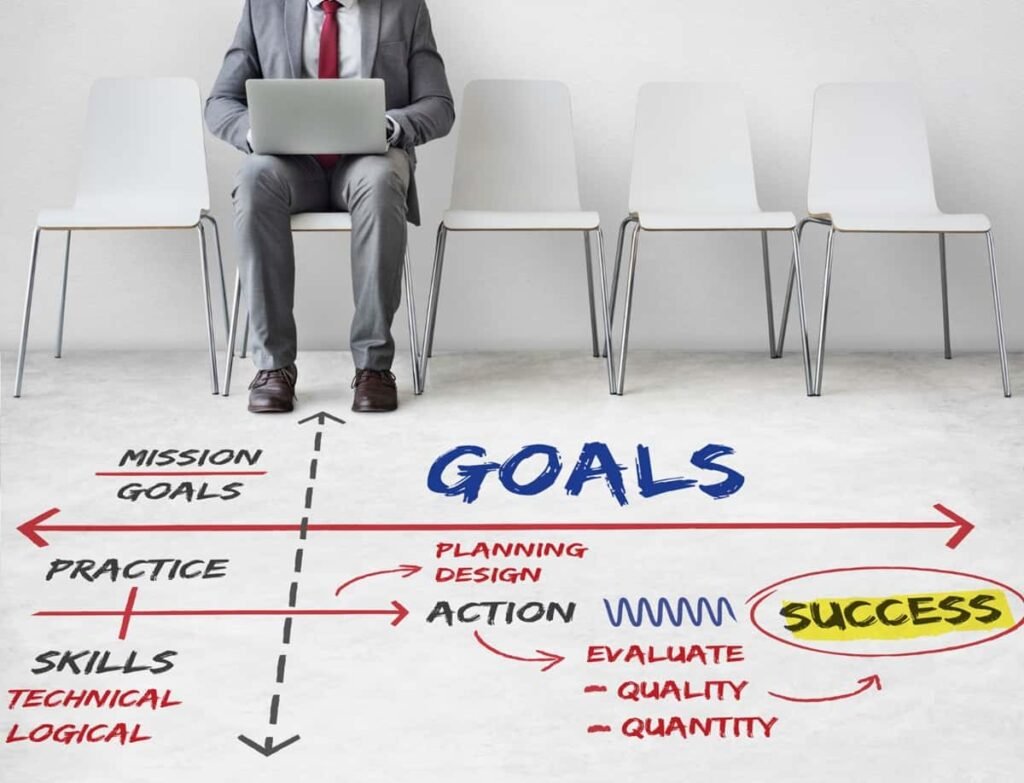Top 7 Best Goal Setting Techniques. Setting goals is the cornerstone of achievement, personal growth, and overall success. Without clear objectives, we drift aimlessly, lacking direction and purpose. But simply having goals isn’t enough. The way we set those goals significantly impacts our likelihood of actually achieving them.
This article dives deep into 7 of the most effective goal-setting techniques, each designed to help you define, plan, and execute your aspirations with greater precision and impact. By incorporating these strategies, you can transform your goals from vague wishes into tangible realities, ultimately skyrocketing your success in any area of your life.
Top 7 Best Goal Setting Techniques

1. The Gold Standard: SMART Goals
No list of goal-setting techniques is complete without mentioning the SMART framework. SMART is an acronym that stands for:

- Specific: Your goal should be clearly defined, leaving no room for ambiguity. Instead of “I want to be healthier,” try “I want to lose 15 pounds.”
- Measurable: You need a way to track your progress. Quantify your goal with concrete metrics. “Lose 15 pounds” is measurable because you can track your weight.
- Achievable: While it’s important to dream big, your goal should be realistic and attainable given your current resources and limitations. Aiming to lose 50 pounds in a month might be too ambitious and lead to discouragement.
- Relevant: Your goal should align with your broader life objectives and values. Make sure it matters to you personally. Losing weight might be appropriate if it improves your health and confidence.
- Time-bound: Set a specific deadline for achieving your goal. This creates a sense of urgency and prevents procrastination. “Lose 15 pounds in 3 months,” adds the time constraint.
Why it Works: The SMART framework provides a structured and logical goal-setting approach. It forces you to think critically about what you want to achieve, how you’ll measure your progress, and when you’ll accomplish it. This level of clarity significantly increases your chances of success.
How to Implement: For every goal you set, ask yourself:
- What exactly do I want to achieve?
- How will I know when I’ve reached my goal?
- Is this goal realistic given my current circumstances?
- Why is this goal important to me?
- By when do I want to achieve this goal?
Answering these questions will help you craft a SMART goal that’s both inspiring and actionable.
2. The “Why Power”: Value-Based Goal Setting
While SMART goals provide a framework for clarity, they sometimes lack the emotional connection needed to fuel long-term motivation. Value-based goal setting bridges this gap by connecting your goals to your core values.

What it is: This technique involves identifying your most important values (e.g., family, creativity, health, security, learning) and then setting goals that directly support those values.
Why it Works: When your goals are aligned with your values, you’re tapping into a deeper sense of purpose and motivation. You’re not just working towards an arbitrary target; you’re striving to live a life that’s congruent with what truly matters to you. This intrinsic motivation makes you more resilient in the face of challenges and setbacks.
How to Implement:
- Identify Your Values: Take some time to reflect on what truly matters to you in life. You can use online resources and questionnaires to help you identify your core values.
- Connect Goals to Values: For each value, brainstorm specific goals that would support it. For example, if “health” is a core value, a relevant goal might be “exercise for 30 minutes, 5 days a week.”
- Prioritize and Refine: Once you have a list of value-aligned goals, prioritize them based on their importance and feasibility. Refine them using the SMART framework for optimal clarity.
Example:
- Value: Family
- Goal: Spend one hour each evening, device-free, connecting with my family. (SMART Goal: Spend one hour each evening, Monday-Friday, from 6:00 PM to 7:00 PM, engaging in activities with my family, free from phones, tablets, and laptops. This will strengthen our bonds and create lasting memories.)
3. The Kaizen Approach: Setting Micro-Goals
The Kaizen philosophy, meaning “continuous improvement,” advocates for breaking down large, daunting goals into smaller, more manageable micro-goals.

What it is: Instead of focusing on the overwhelming end result, you concentrate on taking small, incremental steps forward each day. These steps are so small that they require minimal effort and don’t feel intimidating.
Why it Works: Micro-goals are incredibly effective because they:
- Reduce Overwhelm: Large goals can be paralyzing. Small steps feel achievable, making it easier to get started and maintain momentum.
- Build Momentum: Each small accomplishment creates a sense of progress, which fuels further motivation and builds confidence.
- Cultivate Consistency: The ease of micro-goals encourages consistency, leading to compounding results over time.
- Adapt to Change: Small adjustments are easier to make along the way, allowing you to adapt to unforeseen challenges and optimize your strategy.
How to Implement:
- Break Down Your Big Goal: Divide your overall goal into a series of smaller, more manageable steps.
- Focus on Small, Daily Actions: Identify the smallest action you can take each day that will move you closer to your goal.
- Maintain Consistency: Commit to taking that small action every day, even when you don’t feel like it.
- Track Your Progress: Monitor your progress and celebrate small victories to stay motivated.
Example:
- Big Goal: Write a book.
- Micro-Goal: Write for 15 minutes each day.
4. The Visual Powerhouse: Visualization Techniques
Visualization is a powerful mental tool that involves creating vivid mental images of yourself successfully achieving your goals.

What it is: Imagine yourself already having accomplished your goal. Feel the emotions, see the surroundings, and experience the success as if it were real.
Why it Works: Visualization works because it:
- Reprograms Your Subconscious: By repeatedly visualizing success, you train your subconscious mind to believe that your goal is achievable.
- Boosts Confidence: Seeing yourself succeed mentally builds confidence and reduces self-doubt.
- Increases Motivation: Experiencing the positive emotions associated with achieving your goal fuels your motivation and drives you to take action.
- Improves Performance: Visualizing the steps required to achieve your goal can help you identify potential obstacles and develop effective strategies to overcome them.
How to Implement:
- Find a Quiet Space: Choose a place where you won’t be disturbed.
- Relax and Focus: Take a few deep breaths to relax your body and clear your mind.
- Create a Vivid Mental Image: Imagine yourself having already achieved your goal. See the details, feel the emotions, and engage all your senses.
- Repeat Regularly: Practice visualization for 5-10 minutes each day.
Example: If your goal is to give a successful presentation, visualize yourself confidently delivering the presentation, engaging the audience, and receiving positive feedback.
5. The Two-Pronged Approach: Performance vs. Learning Goals
This technique differentiates between goals focused on achieving a specific outcome (performance goals) and goals focused on acquiring new knowledge or skills (learning goals).

What it is: Recognize that focusing solely on performance can lead to anxiety and risk aversion, while focusing on learning encourages experimentation and growth. The ideal approach involves balancing both types of goals.
Why it Works:
- Performance Goals: Provide a clear target and a sense of accomplishment when achieved. They drive efficiency and results.
- Learning Goals: Foster a growth mindset and encourage continuous improvement. They help you develop the skills and knowledge needed to overcome challenges and achieve long-term success.
How to Implement:
- Identify Both Types of Goals: For each major objective, identify both a performance goal (the desired outcome) and a learning goal (the skills or knowledge you need to acquire to achieve that outcome).
- Balance Your Focus: Don’t become solely fixated on the end result. Allocate time and energy to learning and skill development.
- Celebrate Both Achievements: Acknowledge and celebrate both performance milestones and learning breakthroughs.
Example:
- Goal: Increase sales by 20% (Performance Goal)
- Learning Goal: Master advanced sales techniques through online courses and workshops.
6. The Power of Accountability: Setting Goals with Others
Sharing your goals with others and inviting them to hold you accountable can significantly increase your chances of success.

What it is: Find a friend, family member, coach, or mentor who will support you and check in on your progress.
Why it Works:
- Increased Commitment: Knowing that someone else is monitoring your progress creates a sense of obligation and increases your commitment to your goals.
- Enhanced Motivation: Positive reinforcement and encouragement from your accountability partner can provide a much-needed boost when you’re feeling discouraged.
- Objective Feedback: Your accountability partner can provide valuable feedback and insights that you might not have considered yourself.
- Reduced Procrastination: The fear of letting your accountability partner down can help you overcome procrastination and stay on track.
How to Implement:
- Choose the Right Partner: Select someone who is supportive, reliable, and understands your goals.
- Clearly Define Expectations: Discuss how often you’ll check in, what information you’ll share, and how they can best support you.
- Be Honest and Open: Share your progress, challenges, and setbacks with your accountability partner.
- Provide Reciprocal Support: Offer to be an accountability partner for them as well.
7. The Refinement Loop: Regularly Reviewing and Adjusting Goals
Goal setting isn’t a one-time event. It’s an ongoing process of review, reflection, and adjustment.

What it is: Schedule regular intervals (weekly, monthly, quarterly) to review your progress, assess your strategies, and make any necessary adjustments to your goals.
Why it Works:
- Adapt to Changing Circumstances: Life is dynamic, and unexpected events can derail your plans. Regular reviews allow you to adapt to changing circumstances and adjust your goals accordingly.
- Identify and Address Challenges: Regular reviews provide an opportunity to identify and address any challenges or obstacles that are hindering your progress.
- Refine Your Strategies: You may discover that some of your strategies are not as effective as you had hoped. Regular reviews allow you to refine your approach and optimize your results.
- Maintain Motivation: Tracking your progress and celebrating small victories can help you stay motivated and focused on your goals.
How to Implement:
- Schedule Review Sessions: Block out time in your calendar for regular review sessions.
- Track Your Progress: Keep a record of your progress towards your goals.
- Reflect on Your Experiences: Consider what’s working well, what’s not working, and what adjustments you need to make.
- Make Necessary Adjustments: Don’t be afraid to modify your goals or strategies if necessary.
Conclusion:
Effective goal setting is a skill that can be learned and honed. By incorporating these 7 techniques into your approach, you can transform your aspirations into tangible realities. Remember that the key to success lies not just in setting goals but in setting them strategically, aligning them with your values, and consistently taking action towards their achievement. Start implementing these techniques today and watch your success skyrocket! Good luck!


